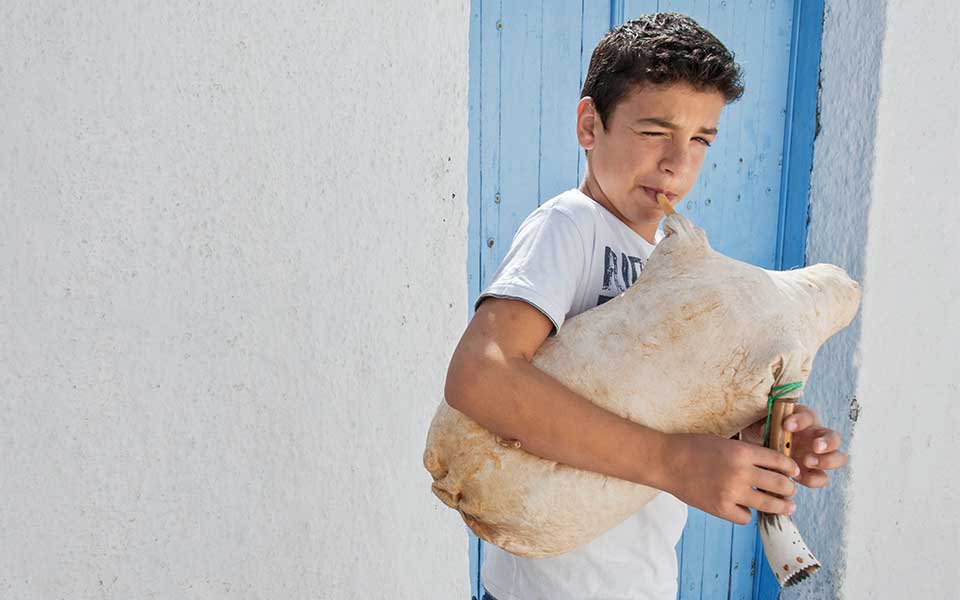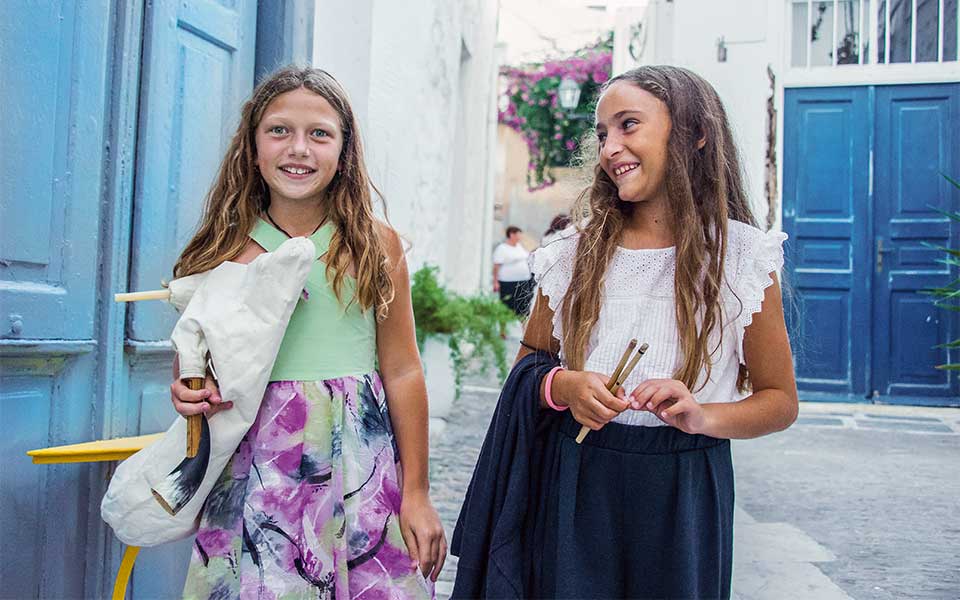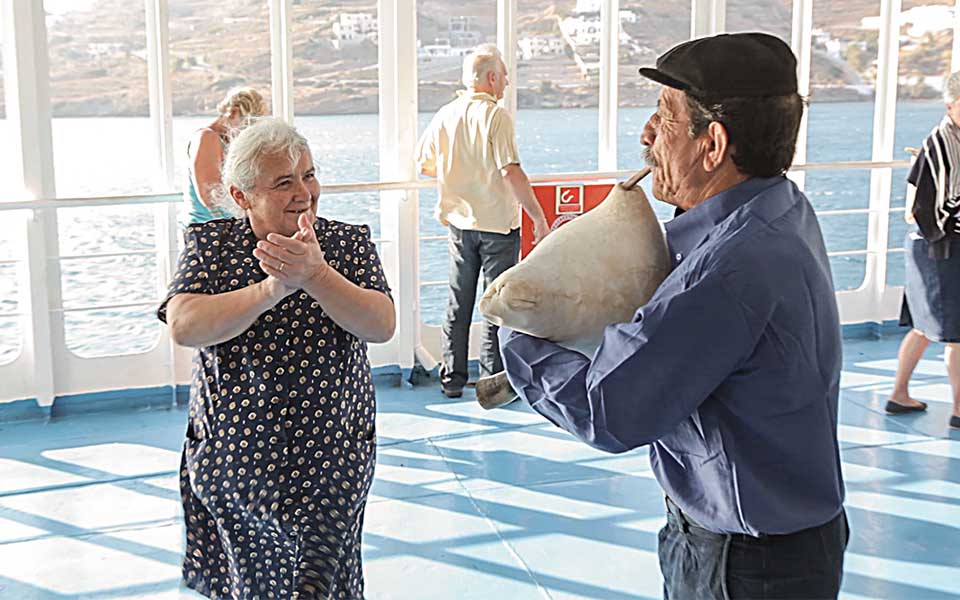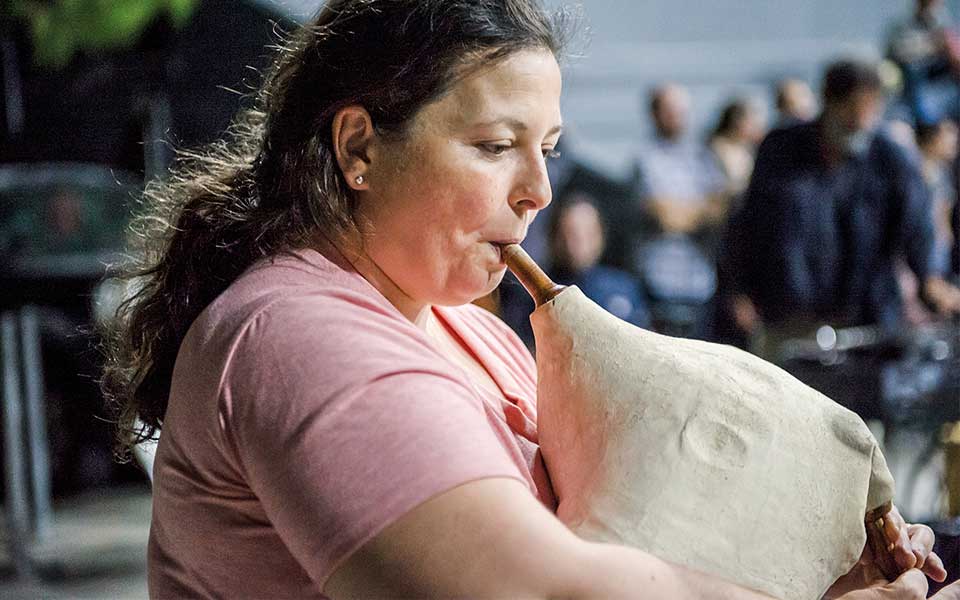5 Magical Open-Air Cinemas to Visit on the...
From Samos to Crete, we've selected...

© John D. Carrnessiotis
When Tasos Anastassiou organized the first Meeting of Aegean Folk Winds and Traditional Music on the island of Kea in 2002, he could not have imagined the enthusiastic response: around 40 musicians arrived from more than 18 islands, more than half of them tsampouna players, an unruly breed that had seemingly all but disappeared along with the decline in agriculture and the ensuing rural exodus. “It was not fashionable, and the people playing it were like dinosaurs with funny mustaches and shepherd sticks,” says Pericles Schinas, a schoolteacher who moved to Karpathos to learn. The festival ignited a revival of the instrument: “By the late 2000s there were teenagers who could get a date because they played tsampouna.”
Born out of the isolated conditions of Aegean islands, the tsampouna (τσαμπούνα) is a simpler version of the Balkan gaida: made of a whole goatskin, a double pipe of cane (καλάμι) and horn, it lacks the harmonic drone pipe, blasting a raw and raucous sound that is utterly soulful. “Shepherds started making the instrument from materials they had at hand,” says Cretan lyrist Alexandros Papadakis. On Kea, where once there were over 100 tsabounierides, “the priest Lefteris Demenegas was the first teacher of the young musicians,” says Anastassiou, who works for the Cultural Directorate of the Cyclades.

Traditionally the tsambouna was handed down among male family members. Eighty-year-old Kean Milianos Lagonis followed in the footsteps of his father and grandfather from the age of four: “I played it on my eight-mile walk to school to scare away the snakes,” he says. The earliest use of the avlos (flute) has been traced back to the Cycladic islands in the third millennium BC. Legend has it that the goddess Athena threw the pipe into the lake after seeing the unflattering image of her puckered face while playing. The satyr Marsyas picked it up and played so well for the Muses that Apollo killed him in a jealous rage, throwing his skin into the river, where it was found by Pan and brought back to life as a bagpipe, or μαρσύαυλος (marsyavlos).
At last women are daring to pick up the pipes. “Women never played because it was always considered something for the boys,” says musician Nina Karamolegkou, who played tsampouna at her own wedding in Santorini. Virtuoso Stefanos Psarrás has found himself in demand as the teacher of more than 20 pupils in the village of Filoti, Naxos. Twelve-year-old student Katerina Gratsia ditched piano lessons at age six after hearing the tsampouna played at a local feast. Her little sister, Maria, is following in her footsteps, starting with the little pipe, or maduraki.

© John D. Carrnessiotis
“I first heard it as a teen in Anafi when I woke in the middle of the night to a couple of guys serenading a woman outside her window with a tsampouna and drum in what is called a kantada,” says historian Eleni Gkika, who gives specialized music tours for the Urban Athens Collective. “There was nothing there at the time—no restaurants or bars, not even roads.” Nomadic and idiosyncratic by nature, the instrument is like a second set of lungs, collapsed when idle and reanimated with the player’s breath. The tsampouna was the instrument that could be carried on foot across the island to play for the panagiri at the Monastery of Panagia Kalamiotissa, on cape Kalamos—the second highest rock in the Mediterranean.
When transport between islands was even scarcer, the rousing call of the tsampouna was a key conduit for Cycladic culture, camaraderie, and community. Its repertoire is common yet idiomatic, the lyrics and steps varying from island to island as points of identity and friendly contention. There is no distinction between performer and audience—everyone participates and songs are never played the same way twice. “It is not something you can learn in school; you have to go to many γλέντια,” Nina Karamolegkou says. “The most difficult thing is the repertoire—what to play when and for whom.” It is like an extension of the body, a feeling of sensuous symbiosis: “It’s like a relationship. It does what it wants, and you have to be ready to do what it tells you to do,” she adds.

© Markus Haaser, 2011
No demure denizen of the concert hall, the tsampouna does not play well with others—limited to six notes, each handmade bagpipe has a slightly different sound—and has no use for a microphone. Its most common companion is the toumpaki, a drum played with two wooden batons. Mykonian drummer Maria Asimomiti has accompanied her 34-year-old brother, considered one of the best of the new generation, since she was 12 years old. Yiannis Asimomitis got his start under the tutelage of the patriarch Michalis “Babelis” Kounanis, of Ano Mera. “You usually learn these instruments on your own; you just have to listen and then play,” she says. “There are some great, famous people on Mykonos who are passing the tradition on to us.”
The community around the tsampouna is like a cult, some call it Dionysian, concerning everything from the making of the instrument to the social context. “The music is seen as vulgar and subversive by many sectors of Greek society,” says Anna Mavroudi, president of the Federation of Cycladic Women’s Associations. Believed to induce a trancelike ecstasy, the tsampouna runs rampant in Naxian carnival festivities, called Apokries, where revelers dressed as satyrs are strapped with phalluses and clanging bells scare away evil spirits.
Embraced early on by the Orthodox Church to entice a more pagan than Christian island populace into the flock, the tsampouna was played at island weddings and religious feasts (panagiria) until it was largely excommunicated in favor of the more cosmopolitan fiddle. When the Junta took power in 1967 it seized the radio waves, broadcasting music sanctioned as suitable to an ideal of Greekness and suppressing vernacular styles and instruments, even the bouzouki. The gaida had been banned after the Greek civil war because it was associated with Communism as the national instrument of Bulgaria. Official music—particularly the tsamiko, a mainland folk dance associated with the 1821 struggle for independence from the Ottomans—was blasted from speakers on exile islands to “reeducate” political prisoners, according to musicologist Anna Papaeti.

© John d. Carnessiotis
Call of the Wild: For the new generation, brought up in the wake of the dictatorship under the homogenizing forces of globalization, the Aegean bagpipe may be an expression of individualism and resistance to conformity. It also embodies a recent trend of young Greeks looking to their roots since the country’s economic crisis deepened a decade ago. Urban groups like Thrax Punks, Transidelia, and Villagers of Ioannina City are fusing punk and psychedelic rock with traditional folk tunes. “There was a backlash against folk music after the dictatorship, but since the 1990s there has been a renaissance of traditional music fueled by the schools,” says Giorgis Nikas, who makes ancient lyres and plays tsampouna for the bands Social Waste and Rotting Christ.
The Pan-Aegean festival has evolved into a popular annual event, moving to a different island each year, with participants jamming as they meet on ferries between Syros, Andros, Mykonos, Paros, Naxos, Ikaria, and Santorini—just like the old days. By 2011, more than 350 musicians of all ages had gathered on Santorini. Filmmaker Yorgos Arvanitis has captured the phenomenon through the eyes of musicians in an exuberant new documentary The Journey of Askavlos—featuring a taverna scene with the legendary Mykonian Dimitris “Stravalogas” Koukas, aka Mitsaras, who passed away a few days ago at the age of 90.

© John d. Carnessiotis
On the night of Saint John’s feast, young Athenians gather on a corner in Kaisariani, bringing food and drink, and build a bonfire. It isn’t exactly organized, it just happens. Bagpipers and drummers come and go, playing until dawn while people wave their hands wildly and jump around. “The sound of the tsampouna makes people go crazy,” says Schinas. “There is something primal about it.” As ethnomusicologist Haris Sarris explains it in the film: “It might be something of a psycho-acoustic nature. You can’t ignore the thing of embracing an object made of leather that looks like a human body, offering your breathe to it as it continually produces little melodies which are repeated cyclically, leading to total ecstasy. It’s both old and new. Cyclicality dates back to ancient times from fire-walking events to rave parties, and the tsampouna has all the characteristics of that cyclicality.” As the song goes: “Dance, dance don’t spare your shoes.”
Last autumn enthusiasts came out on Kea to celebrate the tsampouna in a theatrical ode to Dionysus adapted from Euripides’s Bacchae—a play extolling the union of order and irrationality as well as intoxication and enlightenment. Later that night maestro Lagonis led the festivities at a mountaintop taverna accompanied by local kids on the pipes and drums. As dancers broke into couples for a Cycladic polka, someone shouted: “When are you going to play Greek music?” Follow the piper.
From Samos to Crete, we've selected...
A soulful celebration of longevity, blending...
Charming architecture, unique beaches, rich history,...
More and more Europeans retire to...